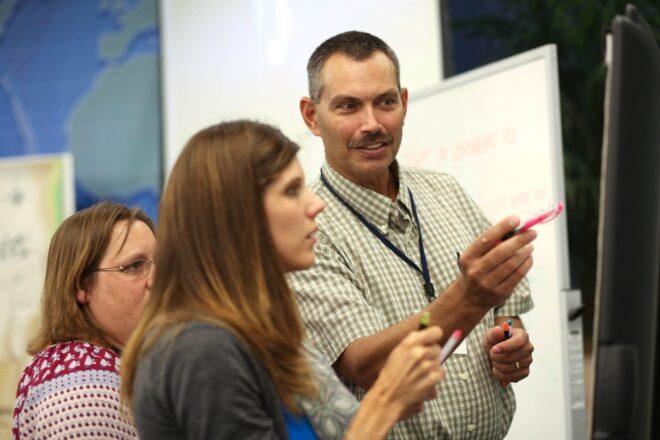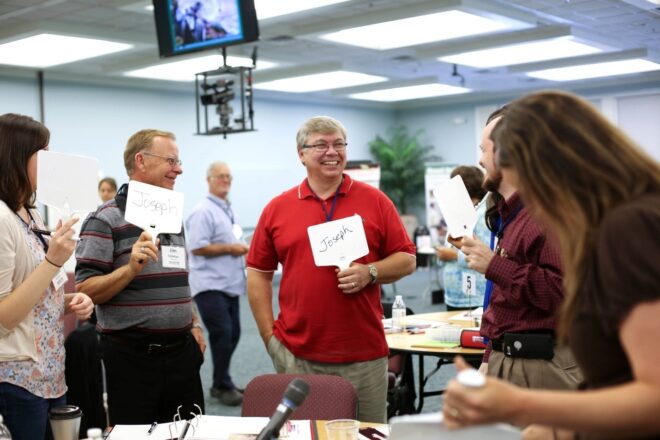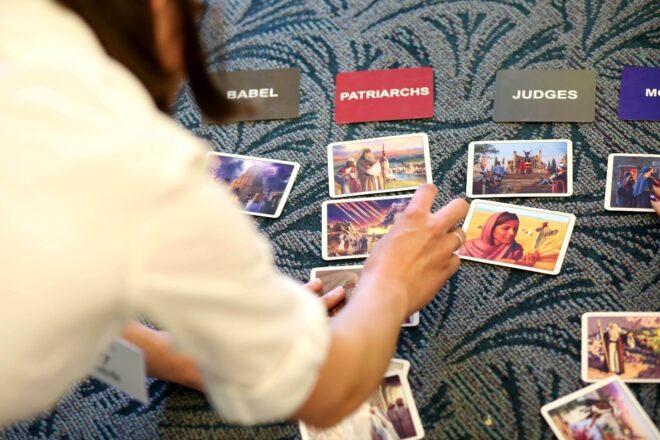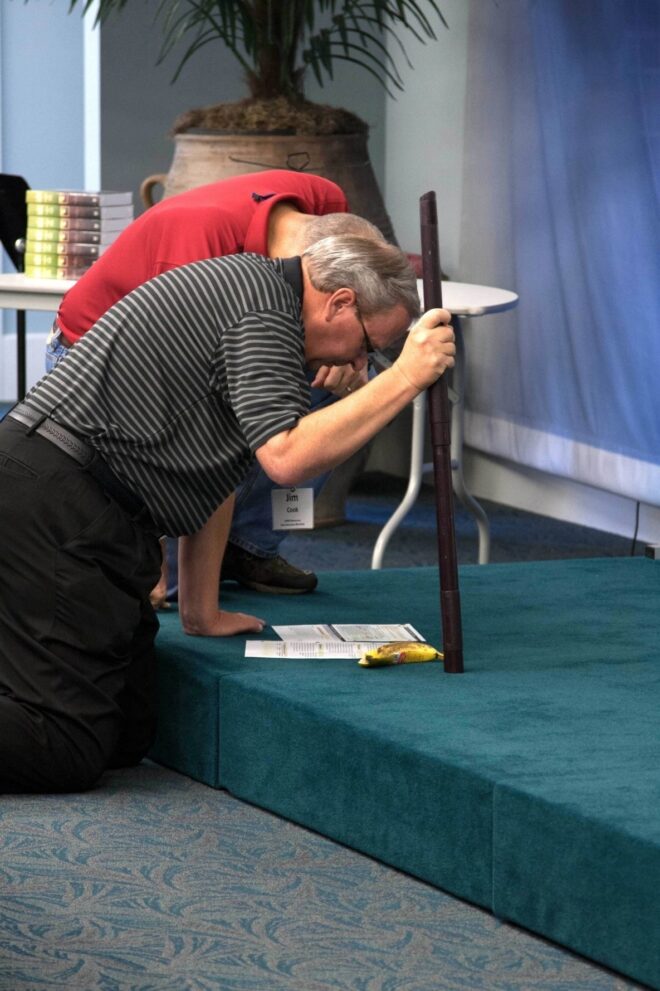Creative Methods for Making Bible Learning Fun for Teens & Adults

The FUN Theory says: FUN is the easiest way to change people’s behavior for the better.
In 2009, Volkswagen came up with this theory: “People prefer fun activities over virtually identical activities that are not as much fun.” Then, they set out to prove it by setting up a FUN stairway side by side with a normal escalator. The experiment: Would people rather ride up a boring escalator or walk up a stairway that is FUN? Here’s what they learned.

Watch this video. Click here: The FUN Theory
Ten FUN & Effective Methods for Teaching the Bible to Teens & Adults
Would most people choose a Bible class that is FUN, or a Bible class that is “same-old, same-old” and maybe boring? The “fun theory” supports what we have known for years – “Students learn best when they are having fun.” Here are ten teaching-learning methods we have found to work effectively with teens and adults.
Table Learning Groups

Set up tables, preferably round tables, for seating four to six students. Set the chairs so that every member of the table group will easily be able to turn to see the class facilitator up front. In order to do that, do not place a chair on the front side of the table.
Plan your lesson to engage table groups in discussions at their tables. For table group discussions, do fun things to appoint leaders for each activity, such as:
- The person who got up earliest this morning.
- The person wearing the most blue.
- The person who stands up last, when you abruptly ask them to stand.
- Have each person at the table roll a die (from a pair of dice) and the person with the highest number gets to appoint a leader, etc.
- Draw a card from a small pile of cards and the lowest (or highest) number card is the leader.
Dyads and Triads

Dyads are pairings of two students for the purpose of working on a specific activity or participating in a paired-discussion. Triads are groups of three students working together or discussing a question among themselves. A variation on dyads and triads is standing dyads and triads—asking two (or three) students to stand up and move to an open space in the room to discuss a question. Standing adds the benefit of getting students up and moving—blood circulating better to rekindle their alertness and rewinding their attention spans.
Flip Charts

Flip charts serve many teaching-learning functions:
- They are great for fun-drawing activities, like – “draw a picture of what you ‘see’ in this passage,” “draw some faces to show the emotions that these characters were feeling at the time this event occurred,” “draw a picture of Noah’s ark based on the description given in the Bible,” etc.
- Flip charts are useful for groups to compile written ideas or thoughts, like – “what are the three most important lessons to be learned from this lesson?” or “what is the one question you’d most like to have answered after reading this passage?” or “create your group’s outline of the Bible passage,” etc.
- Plus, flip charts provide another opportunity to release people from their seats to refresh their attention spans.
Personal Response Boards/Cards

One of the most often questions by teachers is “How do I get my students to respond? They just sit there and stare at me.” No problem! Ask them to write a response and then display it at the same time as other students.
Here’s a great teaching tool that should be more popular with teachers. We call it a “personal response board.” It consists of a small, hand-held white board and a small dry-erasable marker. You can purchase those from Trainer’s Warehouse. Or, if you don’t want to pay $3.50 or so per board, you can just put a stack of 5” x 8” blank index cards on the tables and enough Sharpie markers for each student to have one.
You can ask students to jot down a quick and brief written response or create a simple drawing for expressing their responses to a question. Then, when everyone has written or drawn a response, ask them to hold their cards up for you and others to see.
Floor Activities

Did you ever think of empty spaces on the floor of your classroom as teaching spaces? We use floor space for groups to build Bible maps or construct timelines. And in our The Roots of Faith courses, students arrange Bible eras in chronological order and place Chronological Bible event cards in order, under the correct Bible era cards.
The use of floor space for teaching is only limited by your imagination. And if there is not a lot of empty space in your classroom, move to a hallway or another room close by for these activities.
Tactile Activities

“What are tactile activities,” you ask. Answer: “Any activity that that is literally a hands-on activity.” Some examples you can see in the photos above. But there are many others.

Even adults like to put puzzles together, create paper timelines, and build models, such as a model of the Old Testament tabernacle. Never let yourself think that these kinds of tactile activities are only for kids.
Games

To be a creative teacher of teens and adults, we must shed the notion that games are just for little kids. Most teens and adults like games—card games or table games or TV “gameshow” games or maybe even some light-physical skill games that involve a ball, etc. If you search the internet for “educational games for adults” (or some similar search words) you will discover that there is a rich treasure chest of games available (many of them FREE!) for you online.
If you have money to spend on some tested and tried professionally produced games, take a look at the Trainers Warehouse pages. We especially like the “Thumball,” the “Game Show Presenter” files, and the “Me First” game buzzers.
Role Play

Two words that strike fear in the hearts of shy learners are “role play.” Well-done and properly-acted role play is a very effective instructional method for use with adults or teens. But don’t try to force “square pegs into round holes”—don’t force people to be in up-front role playing if they freak-out at the thought. Assign roles to volunteers or to participants you know will not feel overwhelmed by performing in front of the class. Use role play to communicate a concept or clarify a Biblical event.
Reader’s Theater

“Reader’s theater” is a dramatic presentation of a written script. It doesn’t require memorization, costumes, special lighting, or (in most cases) rehearsals. But be sure to assign reading parts to people who are confident about reading in public. There are many Bible texts where the dialogue script is there for you already. Just assign one student from the class for each speaking-person in the Bible story. In order to enhance the dramatic effectiveness, make assignments ahead of time so the students can practice reading with dramatic emphases.
Velcro® Activity

I could have called this kind of activity, a “hook-and-loop fastener” activity because Velcro® is one of those brand names that is a registered trademark. But, the word “velcro” has stuck in our brains (pun intended) better than “hook and loop.” But, what’s a “velcro activity”?
Over 100 years ago, a guy named John Milton Gregory wrote a book called The Seven Laws of Teaching. Law seven was the “Law of Review an Application.”
VII. Review, review, review, reproducing correctly the old, deepening its impression with new thought, correcting false views, and completing the true.
More modern learning research has proven that review and repetition are key factors in making learning “stick.” But, the word “review” conjures up negative images to many students, so it’s a word that we recommend you avoid using in class. We use “velcro” (in a kind of tongue-in-cheek way) instead. So, a “velcro activity” is not a specific method, it’s a creative review activity. In our The Roots of Faith Bible courses, we include two major velcro activities per day—one right after lunch and the other at the end of the day.
Some examples:
- Pin place names on a blank map.
- Create a Bible map made out of pieces of rope.
- Put names or pictures of Bible events in their proper order.
- Stand with another student and share three major things learned today.
- On a flip chart or other large piece of paper, make a list of five keep “take aways” from today’s lesson.
Watch Some of these FUN Activities in Process

Watch this video. Overview of Old and New Testament Courses
LEARN MORE about The Roots of Faith Chronological Bible Courses






